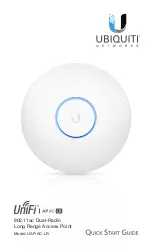
Chapter 5 Wireless LAN
WAH7130 User’s Guide
42
5.1.1 What You Can Do
• Use the
General
screen to turn the wireless connection on or off, set up wireless security
between the WAH7130 and the wireless clients, and make other basic configuration changes
(
).
• Use the
Guest Wi-Fi
screen to set up a second wireless network on your WAH7130 (
• Use the
MAC Filter
screen to allow or deny wireless stations based on their MAC addresses from
connecting to the WAH7130 (
).
5.1.2 What You Should Know
Every wireless network must follow these basic guidelines.
• Every wireless client in the same wireless network must use the same SSID.
The SSID is the name of the wireless network. It stands for Service Set IDentity.
• If two wireless networks overlap, they should use different channels.
Like radio stations or television channels, each wireless network uses a specific channel, or
frequency, to send and receive information.
• Every wireless client in the same wireless network must use security compatible with the AP.
Security stops unauthorized devices from using the wireless network. It can also protect the
information that is sent in the wireless network.
Wireless Security Overview
The following sections introduce different types of wireless security you can set up in the wireless
network.
SSID
Normally, the AP acts like a beacon and regularly broadcasts the SSID in the area. You can hide the
SSID instead, in which case the AP does not broadcast the SSID. In addition, you should change
the default SSID to something that is difficult to guess.
This type of security is fairly weak, however, because there are ways for unauthorized devices to
get the SSID. In addition, unauthorized devices can still see the information that is sent in the
wireless network.
MAC Address Filter
Every wireless client has a unique identification number, called a MAC address.
1
A MAC address is
usually written using twelve hexadecimal characters
2
; for example, 00A0C5000002 or
00:A0:C5:00:00:02. To get the MAC address for each wireless client, see the appropriate User’s
Guide or other documentation.
1.
Some wireless devices, such as scanners, can detect wireless networks but cannot use wireless networks. These kinds
of wireless devices might not have MAC addresses.
2.
Hexadecimal characters are 0, 1, 2, 3, 4, 5, 6, 7, 8, 9, A, B, C, D, E, and F.
Summary of Contents for WAH7130
Page 4: ...Contents Overview WAH7130 User s Guide 4...
Page 8: ...Table of Contents WAH7130 User s Guide 8...
Page 9: ...9 PART I User s Guide...
Page 10: ...10...
Page 25: ...25 PART II Technical Reference...
Page 26: ...26...
Page 32: ...Chapter 3 Monitor WAH7130 User s Guide 32...
Page 40: ...Chapter 4 WAN WAH7130 User s Guide 40...
Page 48: ...Chapter 5 Wireless LAN WAH7130 User s Guide 48...
Page 54: ...Chapter 7 DHCP Server WAH7130 User s Guide 54...
Page 72: ...Chapter 10 Maintenance WAH7130 User s Guide 76...
Page 78: ...Chapter 11 Troubleshooting WAH7130 User s Guide 82...
Page 82: ...Appendix A Common Services WAH7130 User s Guide 86...
Page 92: ...Appendix B Pop up Windows JavaScript and Java Permissions WAH7130 User s Guide 96...
Page 98: ...Appendix C Legal Information WAH7130 User s Guide 102...
Page 102: ...Index WAH7130 User s Guide 106...
















































